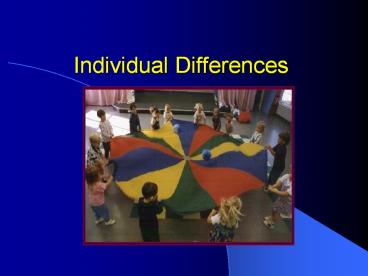Individual Differences - PowerPoint PPT Presentation
Title:
Individual Differences
Description:
Degree to which develop proficiency dependent on if possess necessary underlying ... Practical Application. Expect to see differences in patterns of people's abilities ... – PowerPoint PPT presentation
Number of Views:90
Avg rating:3.0/5.0
Title: Individual Differences
1
Individual Differences
2
Individual Differences
- Relatively stable enduring characteristics
unique to individuals - Height, body type, etc.
- of fast twitch muscle fibers
- Affect the rate potential
for developing skill
proficiency
3
Motor Abilities
- Genetic traits
- Cannot be modified thru practice
- Prerequisite for skilled performance
- Degree to which develop proficiency dependent on
if possess necessary underlying
abilities
4
Abilities Skills
- Inherited traits
- Stable enduring
- Few in number
- Underlie performance of many skills
- Developed with practice
- Modifiable
- Many in number
- Depend on different subsets
5
Capabilities
- Characteristics subject to change as result of
practice - Represent potential to excel in performance of
task
Multilimb Coordination
Person A
Person B
6
Categorizing Motor Abilities
- 11 Perceptual Motor Abilities
- 9 Physical Abilities
- All abilities may not
yet be identified - Tracking
- Eye-Foot Coordination
- Dynamic Balance
- Static Balance
7
Perceptual Motor Abilities
Control precision Ability to make highly controlled movement adjustments Dribbling a soccer ball
Multi-limb Coordination Ability to coordinate numerous limb movements simultaneously Spiking a volleyball
Reaction Time Ability to rapidly initiate a response Start in swimming race
Rate Control Ability to make continuous speed and direction adjustments Mountain biking
8
Physical Proficiency Abilities
Dynamic Strength Ability to exert force repeatedly Rock Climbing
Explosive Strength Ability to create maximum effort by combining force velocity Throwing a javelin
Dynamic Flexibility Ability to make repeated, rapid flexing movements Springboard diving
Gross Body Coordination Ability to coordinate numerous movements simultaneously while in motion Slalom Skiing
9
What do you think?
- Can an individual have abilities but not be
skilled? - Can an individual be skilled without ability?
10
Practical Application
- Expect to see differences in patterns of peoples
abilities - Individual pattern will facilitate better
performance on some tasks rather than others - Ability pattern only one factor contributing to
performance
11
Underlying Abilities - Volleyball Spike
- Control Precision
- Multi-limb Coord.
- Rate Control
- Aiming
- Explosive Strength
- Trunk Strength
- Dynamic Flexibility
12
Skill Subsets
13
Task Analysis
- Choose a skill
- Perform task analysis
- Determine underlying abilities required to
achieve high degree proficiency
14
Perceptual Motor Abilities
- Multilimb coordination
- Control precision
- Response orientation
- Reaction time
- Speed of arm movement
- Rate control
- Manual dexterity
- Finger dexterity
- Arm-hand steadiness
- Wrist/finger speed
- Aiming
15
Physical Proficiency Abilities
- Static strength
- Dynamic strength
- Explosive strength
- Trunk strength
- Extent flexibility
- Dynamic flexibility
- Gross body coordination
- Stamina
16
Predicting Future Performance
- Possible?
- Problems?









![[PDF] Handbook of Individual Differences in Social Behavior 1st Edition Kindle PowerPoint PPT Presentation](https://s3.amazonaws.com/images.powershow.com/10078350.th0.jpg?_=202407130612)





















